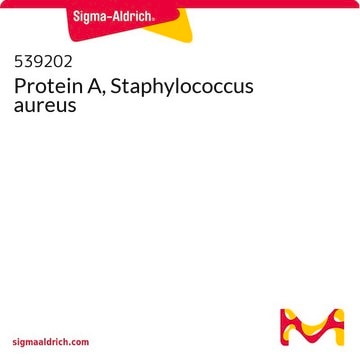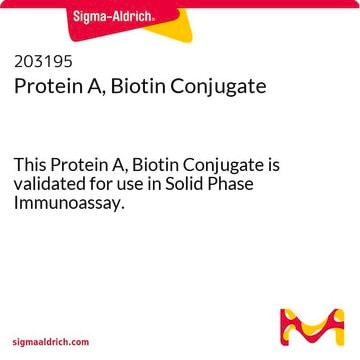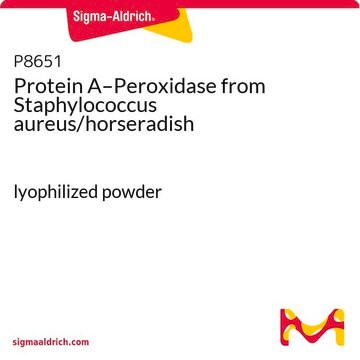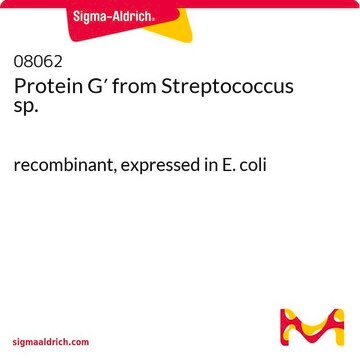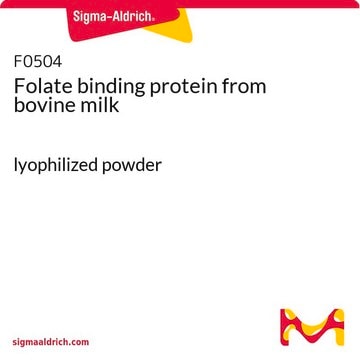P2165
Protein A–Biotin from Staphylococcus aureus
lyophilized powder
Autenticatiper visualizzare i prezzi riservati alla tua organizzazione & contrattuali
About This Item
Prodotti consigliati
Coniugato
biotin conjugate
Livello qualitativo
Forma fisica
lyophilized powder
Composizione
Protein, ≥70% biuret
Grado di funzionalizzazione
3.0-8.0 mol biotin per mol Protein A
Temperatura di conservazione
2-8°C
Descrizione generale
Protein A (SpA) is a 42kDa virulence factor produced by Staphylococcus aureus, and is composed of five highly homologous consecutive extracellular Ig-binding domains, namely domains E, D, A, B, and C. This protein is present in both secreted and membrane-associated forms.
Specificità
Binds IgG only from most mammals, except rat, goat, and sheep
Azioni biochim/fisiol
Protein A (SpA) causes B cells death in vitro, by binding to the Fc region of antibody and the Fab regions of the B-cell receptor, thus inhibiting its opsonophagocytosis. This protein is thought to be implicated in the evasion of host immune responses by Staphylococcus aureus, and thus, might be a candidate for vaccine development approaches to prevent severe S. aureus infections. S. aureus is responsible for nosocomial infections as well as a variety of human infections, such as food poisoning, toxic shock syndrome, endocarditis, septicemia, skin infections, soft tissue infections, and bone infections. It is also responsible for bovine and ovine mastitis. SpA typing or DNA sequence analysis of the variable repeat region of protein A gene is useful in determining S. aureus outbreak strains from those strains that are epidemiologically insignificant.
Stato fisico
Lyophilized powder containing sodium citrate
Nota sulla preparazione
Prepared from P 6031, coupled to biotin by an amide bond through an aminocaproyl spacer.
Esclusione di responsabilità
Unless otherwise stated in our catalog or other company documentation accompanying the product(s), our products are intended for research use only and are not to be used for any other purpose, which includes but is not limited to, unauthorized commercial uses, in vitro diagnostic uses, ex vivo or in vivo therapeutic uses or any type of consumption or application to humans or animals.
Certificati d'analisi (COA)
Cerca il Certificati d'analisi (COA) digitando il numero di lotto/batch corrispondente. I numeri di lotto o di batch sono stampati sull'etichetta dei prodotti dopo la parola ‘Lotto’ o ‘Batch’.
Possiedi già questo prodotto?
I documenti relativi ai prodotti acquistati recentemente sono disponibili nell’Archivio dei documenti.
I clienti hanno visto anche
M Balasch et al.
Journal of comparative pathology, 121(2), 139-148 (1999-07-16)
This report describes the experimental inoculation of conventional pigs with a tissue homogenate obtained from two pigs affected with postweaning multisystemic wasting syndrome (PMWS). Eight 2-month-old pigs were inoculated by the intranasal route, and two pigs were left as uninfected
Anil K Pal et al.
Biosensors, 10(10) (2020-09-30)
We report a novel self-referenced diffraction-based leaky waveguide (LW) comprising a thin (~2 µm) film of a photofunctionalisable hydrogel created by covalent attachment of a biotinylated photocleavable linker to chitosan. Streptavidin attached to the chitosan via the photocleavable linker was
spa typing method for discriminating among Staphylococcus aureus isolates: implications for use of a single marker to detect genetic micro- and macrovariation.
Koreen L et al
Journal of Clinical Microbiology, 42(2), 792-799 (2004)
Regina Stoltenburg et al.
International journal of molecular sciences, 19(2) (2018-03-03)
New, as yet undiscovered aptamers for Protein A were identified by applying next generation sequencing (NGS) to a previously selected aptamer pool. This pool was obtained in a classical SELEX (Systematic Evolution of Ligands by EXponential enrichment) experiment using the
M Graille et al.
Proceedings of the National Academy of Sciences of the United States of America, 97(10), 5399-5404 (2000-05-11)
Staphylococcus aureus produces a virulence factor, protein A (SpA), that contains five homologous Ig-binding domains. The interactions of SpA with the Fab region of membrane-anchored Igs can stimulate a large fraction of B cells, contributing to lymphocyte clonal selection. To
Il team dei nostri ricercatori vanta grande esperienza in tutte le aree della ricerca quali Life Science, scienza dei materiali, sintesi chimica, cromatografia, discipline analitiche, ecc..
Contatta l'Assistenza Tecnica.
